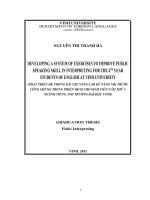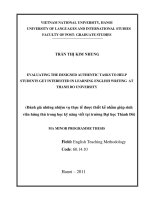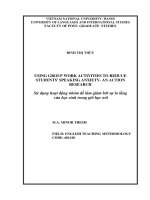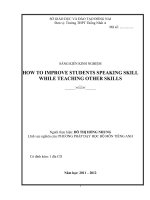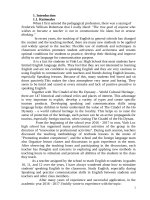Using summary graphs after lessons to develop students speaking skill in basic english 10
Bạn đang xem bản rút gọn của tài liệu. Xem và tải ngay bản đầy đủ của tài liệu tại đây (121.34 KB, 20 trang )
THANH HOA EDUCATION AND TRAINING DEPARTMENT
HOANG HOA 3 HIGH SCHOOL
EXPERIENCE INITIATIVE
USING SUMMARY GRAPHS AFTER LESSONS TO
DEVELOP STUDENTS’ SPEAKING SKILL
IN BASIC ENGLISH 10
Implementer: Lê Thị Gấm
Position: Teacher
Experience initiative in the subject: English
THANH HOA YEAR 2019
CONTENT TABLE
CONTENTS
PART I: OPENING
I. Reasons for choosing the theme
II.
Study purposes
III. Study objects
IV. Study methods
V.
Some innovations of the theme
PART II: STUDY CONTENTS
Chapter I: Argument grounds
1. Theoritical grounds.
2. Practical grounds.
Chapter II: Real situations
1. Students.
2. Teachers.
3. Material facilities.
4. Survey results before using Summary Graphs.
Chapter III: Some experience used to improve real situations
I. General understanding of using Summary Graphs.
1. What is the "Summary Graph" technique?
2. Advantages of a Summary Graph.
3. These bases to choose the method of using a Summary
Graph in the lecture.
4. How to design a Summary Graph.
5. The steps of designing a Summary Graph to a lesson.
6. How to organize teaching by the method of using a
Summary Graph.
II. Some examples of using Summary Graphs after lessons to
develop students’ speaking skill in basic English 10.
Chapter IV: Study results, experience lessons and measures
1. Study results.
2. Experience lessons and measures.
PART III: CONCLUSION AND PROPOSALS
1. Conclusion.
2. Proposals.
PAGES
3
3
3
4
4
4
5
5
5
5
6
6
6
6
6
7
7
7
7
7
7
8
8
8
16
16
16
18
18
18
PART I: OPENING
I. REASONS FOR CHOOSING THE THEME.
With the speedy development of the world today, English is widely used in
every field of life. It is not only the native language of many countries but also
the most popular communication language of people around the world.
In order to promote international integration, communication languages
especially English have played an integral part in understanding and cooperation
among nations. Therefore, our Vietnamese education has paid special attention
to teaching English at schools. Among the skills, speaking is considered to be
the most important one. It helps us communicate, understand and cooperate with
each other easily.
Learning a language without being able to speak it in specific situations of
daily life is like having hands but using them for nothing. It is no use learning a
language without using it for oral communication purposes. Moreover, English
is an international language which is widely used in most international and
regional events. Speaking English fluently and confidently helps students a lot
not only in their life but also in their future work.
With those practical goals, the English program at secondary school centres
on forming and developing basic knowledge and skills to students about the
English language and necessary intellectual qualities so that they can either
continue further study or start their working life.
To meet these practical demands, each teacher should study and choose
teaching methods which are suitable to both himself/herself and his/her students.
This is very important to achieve good teaching and learning results.
Actually, at most countryside schools in general and at Hoang Hoa 3 High
School in particular, the results of teaching and learning English have been
better and better recently, but there exist many disadvantages. The biggest
difficulty here, I think, is how to help students speak English fluenty not only in
class but also in real life.
With my experience in teaching English at Hoang Hoa 3 High School, I have
researched reference documents, learned from co-workers as well as applied
many different teaching methods. I have gained some first positive results, so I
would like to choose the theme “Using Summary Graphs after lessons to
develop students’ speaking skill in basic English 10”.
II. STUDY PURPOSES.
- Analysing real situations of teaching the speaking skill.
- Presenting some experience in teaching the speaking skill to raise general
learning effects.
- Using what students have learnt to develop their speaking skill.
- Helping students feel confident when they present their ideas in English in
front of other people.
III. STUDY OBJECTS.
- Real situations of teaching the speaking skill at Hoang Hoa 3 High School.
- Some lessons in basic English 10.
IV. STUDY METHODS.
1. Exploiting the basic English textbook 10 and reference documents.
2. Exploiting teaching aids.
3. Exploiting students’ synthetic ability.
4. Working positively individually and in small groups.
V. SOME INNOVATIONS OF THE THEME.
- Helping students to change their input knowledge into output knowlegde.
- Promoting students’ abilities to synthesize what they have learnt in lessons:
students recall vocabularies, structures, understanding about the topic they have
studied to speak.
- Providing students with chances to cooperate with each other in completing
their duty, so that students can learn how to solve the problems by themselves.
- Bettering students’ confidence when they speak English in front of other
people.
PART II: STUDY CONTENTS
CHAPTER I: ARGUMENT GROUNDS
1. Theoritical grounds.
Just when students start learning English, they get accustomed to four
basic skills: listening, speaking, reading and writing. It is through these four
skills that teachers pass knowledge to students and students gain their
knowledge. Among these four skills, speaking is an important skill to students. It
requires that teachers not only understand well effective teaching methods but
also apply smoothly the principle “Learning parallels hands-on” [4]
Starting from the view of “Learners are the centre”, teaching and learning
methods have changed greatly. Teachers are not those who hold knowledge and
pass it to students, but those who guide, support, consult and check students’
working. Students do not absorb knowledge passively. Becoming the centre of
the teaching-learning process, students are completely active and creative in
study to achieve good learning results and know how to apply knowledge in real
life. [3]
From the grounds above, how to apply innovative methods of teaching the
speaking skill is very important. It helps students feel confident when they
present their ideas in front of other people and communicate effectively in daily
life. This meets the real demands of learning a language.
2. Practical grounds.
Most high schools have used new English teaching and learning materials,
which ask students to develop equally all four skills, among which the speaking
one requires that students have to spend much time practising not only in class
time but also outside class so that they can communicate better in English.
In order to raise the effect of students’speaking English, both teachers and
students need to have good preparations before each lesson. For teachers, they
had better study each lesson carefully, choose suitable teaching methods to
students’ levels, design proper teaching steps and use teaching aids to achieve
the aims. Besides, teachers should also ask students to prepare necessary things
before the lessons, find out and apply a wide variety of practice forms which are
suitable to material facilities of each school to improve students’ English.
When experimenting in some classes of grade 10 at my school, I have
gained some encouraging results. My periods of teaching become more
interesting and exciting with students’ speaking English after each lesson, which
makes students more active and betters their communication in English.
CHAPTER II: REAL SITUATIONS
1. Students.
Generally, the level of students’ knowledge is quite low due to the difficult
economic conditions in the poor countryside and little contact with situations in
which they use English. Besides, the English knowledge of students is not equal
in the same class and among classes in the same grade. Besides, the number of
students in a class is quite high (about 40-45 students). These result in
difficulties when teachers decide to choose methods as well as control class
activites during speaking lessons.
2. Teachers.
After testing some teaching methods, teachers often feel discouraged
because students do not participate in activities actively. Thus, the practical
results are not as good as expected ones. Gradually, teachers seem not to pay
serious attention to promoting students’ speaking English. They often teach each
lesson separately with few chances for students to practice speaking skill. They
often use some simple traditional techniques to teach tasks in each unit quickly.
Therefore, most of class time is spent on controlled tasks in textbook. Students
rarely have time to speak English freely about the topic they have learnt.
3. Material facilities.
Due to the lack of essential material facilities especially projectors, most
teachers do not make full use of such teaching aids as diagrams, pictures, video
clips,…It often takes much time to prepare diagrams on papers.
With these limitations, the effect of speaking tasks is not good enough to
satisfy the general purposes. It is like a vicious circle which has no exit for quite
a long time.
4. Survey results before using Summary Graphs.
(Average percentage on completing speaking tasks)
Class
10A1
10A6
Student
number
42
45
Levels of task completion
Under 50%
50% - 80%
Over 80%
25
59,5%
12
28,6%
5
11,9%
22
48,9%
19
42,2%
4
8,9%
Class 10A1 is chosen to become the experimental class and 10A6 is the control
class in my study.
CHAPTER III:
SOME EXPERIENCE USED TO IMPROVE REAL SITUATIONS
I. General understanding of using Summary Graphs. [5]
1. What is the "Summary Graph" technique?
The summary graph is a diagram that clearly outlines the contents of a
topic. The summary chart can be written on a large paper, on a transparent paper,
on the board or on the projector.
2. Advantages of a Summary Graph.
- It presents a summary of information about a newly-learned topic.
- Basing on the diagram, students can recall the contents, vocabularies and
structures they have just learned.
- Students can practice English speaking skills based on the information
contained in the diagram and students' memorization through the lesson.
- It helps to pratice students’ confidence in speaking English in public.
- It helps students become familiar with how to summarize the lesson contents
scientifically in the process of learning all subjects in general.
- The summary graph of a lesson can also be used for the check-up of the old
lesson in the next learning period.
3. These bases to choose the method of using a Summary Graph in the
lecture.
- Based on the objectives, contents of the lesson or other factors such as
facilities, psychological characteristics, thinking ability of students to apply the
Summary Graph method to teaching.
- A Summary Graph should show the content structure of a lesson in a
appropriate logic. The design of a Summary Graph should be based on the
contents of the lesson in the textbook and the knowledge logic that needs
forming in students’ understanding. The content of the lesson consists of
knowledge units that are the main contents of the lesson. A Summary Graph
should show the basic knowledge, central knowledge of the lesson and the
relationships between those knowledge units. Therefore, when we build a
Summary Graph, pay attention to the logic of the lesson content, we should not
abuse graphs.
4. How to design a Summary Graph.
- Write the topic name in the center or draw an image that reflects the topic.
- From the central theme, draw the main branches. On each main branch, write a
large content of the topic.
- From each main branch, draw the sub-branches to write the contents of that
branch.
- Continue like that for the next groups of information.
5. The steps of designing a Summary Graph to a lesson.
+ Step 1: Determining the lesson objectives
Lesson objectives are the requirements for students to implement when they
study a lesson. There are many factors that influence the determination of lesson
objectives. The most notable are the elements: Lesson contents, students'
cognitive abilities, teacher’ capacity.
+ Step 2: Determining the activity
Determining activities in a lesson can be based on a graph. (In this research
topic, Graph is applied to revise and summarize the lesson contents after the
lesson is finished. This is done in the form of practice to develop speaking skills
for students)
+ Step 3: Creating a Summary Graph of a lesson after conducting learning
activities.
6. How to organize teaching by the method of using a Summary Graph.
This research topic focuses on organizing the research for students to use
and exploit a Graph to summarize the lesson contents with a view to developing
speaking skills for students.
The specific steps:
Step 1: The teacher shows a Summary Graph that has already been prepared.
Step 2: Depending on the students, teachers can ask students to work
individually or in pairs or small groups (3-4 students).
Step 3: Students work individually or in groups (teachers can help if students
meet any obstacles)
Step 4: Depending on the remaining time of the lesson, the teacher calls students
(2-4 ones) to present information in the graph.
Step 5: The teacher comments, adds and covers the whole content of the leson’s
Summary Graph.
II. Some examples of using Summary Graphs after lessons to develop
students’ speaking skill in basic English 10.
1. UNIT 6: AN EXCURSION – PART C: LISTENING (Page 67-68) [1]
glorious Sunday
meet: schoolgate, on time
way: long, by bus, sing happily
Weekend
picnic
Botanical Garden: peaceful, quiet, large glassland
activities: walk, play games, sing, dance, take
photographs, have lunch, sleep soundly
afternoon: play games, go home
Some key words students have learnt after the listening lesson:
- glorious
- schoolgate
- Botanical Garden
- destination
- spacious
- delicious
- grassland
Expected speaking:
A class of students had a weekend picnic in a Botanical Garden on a
glorious Sunday. They met at schoolgate on time. They went by bus. It’s a long
way to the destination, so they sang happily on the way. The Botanical Garden
was very spacious, peaceful and quiet. It had a large grassland. They did many
activities in the garden such as walking, playing games, singing, dancing, taking
photographs, etc… They had a delicious meal in the garden. After lunch, they
slept soundly. In the afternoon, they continued to play some more games and
then they went home.
2. UNIT 9: UNDERSEA WORLD – PART C: LISTENING (Page 98) [1]
mammals, live in water
largest (on earth), most intelligent (in the ocean)
feed in cold oceans (favorite food: krill)
Whales
(some) migrate into warm waters (bear calves)
danger (hunting pressure)
no measures → disappear forever
Some key words and phrases students have learnt after the listening lesson:
- mammal
- krill
- migrate into
- bear
- calf
- be in danger
- due to
- hunting pressure
- take measures
Expected speaking:
Whales are mammals, not fish. They live in water all their life. They are
the largest animals on earth and the most intelligent in the ocean. They like
feeding in cold oceans because there are a lot of krills – their favorite food.
Some whales migrate into warm waters to bear their calves. Whales are now in
danger due to heavy hunting pressure. If we didn’t take measures to protect
them, they would disappear forever.
3. UNIT 11: NATIONAL PARKS – PART C: LISTENING (Page 115) [1]
First ( Vietnam, open in 1960, 160 km South west of
Hanoi, 3 provinces: Ninh Binh, Hoa Binh,
Thanh Hoa)
Cuc
Phuong
National
Park
200 km2 (flora: 2,000, fauna: 450)
visitors (100,000 in 2002; see: animals and plants,
work done → protect)
historic features (Nguyen Hue’s army stationed,
attacked and defeated Qing invaders – Spring 1789)
Muong ethnic minority (bee keeping and farming)
Some key words and phrases students have learnt after the listening lesson:
- officially
- be located in
- flora
- fauna
- historic features
- attack
- invader
- ethnic minority
Expected speaking:
Cuc Phuong National Park is the first National Park of Vietnam. It was
officially opened in 1960. It is located 160 km South west of Hanoi and it spans
3 provinces: Ninh Binh, Hoa Binh and Thanh Hoa. It covers about 200 square
kilometres with 2,000 species of flora and 450 species of fauna. Every year
many visitors come to visit Cuc Phuong. For example, in 2002, there were about
100,000 visitors coming to visit it. They come to see plants and animals and the
work done to protect the National Park. Cuc Phuong National Park also has
historic features. This was the place where Nguyen Hue’s army stationed,
attacked and defeated Qing invaders in the Spring of 1789. Cuc Phuong is also
the home of Muong ethnic minority who live mainly on bee keeping and
farming.
4. UNIT 12: MUSIC – PART A: READING (Page 124 - 125) [1]
make humans different from all other animals
Music
communicate (express ideas, thoughts; show emotions:
anger, love, hate, friendship; convey:
hopes, dreams )
integral (important events, special occasions: festivals
- joyful, funerals – solemn, mournful, lull
babies, wake up)
entertain (happy, excited)
Without music?
Some key words and phrases students have learnt after the reading lesson:
- emotion
- convey
- integral
- funeral
- solemn
- mournful
- lull
- delight the senses
Expected speaking:
Music plays an important role in people’s life. It makes humans different
from all other animals. Music helps people communicate many things such as
expressing ideas and thoughts; showing emotions like anger, love, hate,
friendship; conveying hopes and dreams, etc.. Music also plays an integral part
in important events and special occasions. It adds joyful atmostphere to
festivals, it makes funerals more solemn and mournful, it helps to lull babies to
sleep at night and wake people up in the morning…Besides, it entertains us by
making us happy and excited. It also delights our senses. What would our life be
like without music?
5. UNIT 12: MUSIC – PART D: WRITING (Page 129) [1]
famous, talented
born: 15/11/1923, Nam Dinh, poor workers’ family
start composing music: young (first song: 1939)
Van Cao
Tien Quan Ca (national anthem: 1944)
rural life (sweet, gentle, lyrical)
artistic works: songs, poems, paintings
die: 10/7/1995
appreciated by the Vietnamese people
Some key words and phrases students have learnt after the writing lesson:
- national anthem
- be born into
- compose
- rural life
- gentle
- lyrical
- artistic works
- appreciate
Expected speaking:
Van Cao was a famous and talented musician of Vietnam. He was born on
November 15th 1923 in Nam Dinh, into a poor workers’ family. He started
composing music at a very young age in 1939 (when he was 16 years old) and
he quickly became famous. In 1944, he wrote Tien Quan Ca which soon became
the National Anthem of Vietnam. He wrote about rural life in Vietnam. His
music was sweet, gentle and lyrical. His artistic works included songs, poems
and paintings. He died on July 10th 1995. He was highly appreciated by the
Vietnamese people.
6. UNIT 13: FILMS AND CINEMA – PART B: SPEAKING (Page 135) [1]
(This is a suggestion for student to talk about a film they have seen. Students can
base on this outline to talk about other films they have seen or they like
watching).
cartoon, series of comedy short episodes
made in America
special friendship between two cute animals
Film
“Tom and
Jerry”
little mouse Jerry
big cat Tom
cunning, intelligent
play tricks on the cat
stupid, greedy
take revenge of the mouse
get into troubles, willing to help each other
happy, funny endings
Expected speaking:
Of all the films I have seen, “Tom and Jerry” is the one I like most. It is a
cartoon with series of comedy short episodes. It is made in America. The film is
about the special friendship between two cute animals: a little mouse and a big
cat. The mouse Jerry is so cunning and intelligent. It likes playing tricks on the
cat, while the cat is stupid and greedy. It always thinks of ways in order to take
revenge of the mouse. However, whenever one of them gets into real troubles,
the other is always willing to help out. The film has happy and funny endings.
Not only small children but also adults like watching this film.
7. UNIT 14: THE WORLD CUP – PART A: READING (Page 142-143) [1]
international football tournament (every 4 years)
most popular sporting event
FIFA (govening body): set up -1904
The World
Cup
First World Cup
1930
13 teams
host: Uruguay
final match: Uruguay
&Argentian
champion: Uruguay
32 finalists
2002 World Cup
first in Asia
held byJapan and South Korea
champion: Brazil (win the
trophy 5 times)
honored title
Some key words and phrases students have learnt after the reading lesson:
- tournament
- be held
- host
- final match
- defeat
- champion
- compete
- trophy
- honored title
Expected speaking:
World Cup is the international football tournament. It is held every four
years. It is considered the most popular sporting event in the world. Although its
governing body FIFA was set up in 1904, it was not until 1930 that the first
World Cup took place. Only 13 national football teams took part in the
tournament. The host nation Uruguay competed with Argentina in the final
match. Uruguay defeated Argentina and became the first champion in the history
of the World Cup. Now there are 32 finalists. The 2002 World Cup was played
in Asia for the first time. It was jointly held by Japan and South Korea. Brazil
became the champion. They won the trophy five times. All nation football teams
hope to win this honored title.
8. UNIT 14: THE WORLD CUP – PART C: LISTENING (Page 147) [1],[2]
one of the greatest football players
born: 1940, Brazil
famous: powerful kicking, controlling the ball
Pelé
1956: join a Brazilian football club
1962: lead the team to its first world club
championship
only player – 3 World Cup (1958, 1962, 1970)
1974: 1,200 goals
1977: retire
football international ambassador (promote peace,
understanding through friendly sport activities)
Some key words and phrases students have learnt after the listening lesson:
- powerful kicking
- control the ball
- championship
- retire
- ambassador
- promote
Expected speaking:
Pelé is considered one of the greatest football players in the world. He
was born in 1940 in Brazil. As a football player, he was famous for his powerful
kicking and controlling the ball. In 1956, he joined a Brazilian football club and
he led the team to its first world club championship. He was the only football
player who took part in three World Cups, in 1958, 1962 and 1970. By 1974, he
had scored 1,200 goals. He retired in 1977. After that he worked as a football
international ambassador. He worked to promote peace, understanding through
friendly sport activities.
CHAPTER IV:
STUDY RESULTS, EXPERIENCE LESSONS AND MEASURES
1. Study results.
Through the study and lessons which are designed and carried out
according to the suggested ways, most students become more interested in the
speaking lesson. Besides, they take part in the speaking tasks more actively. As a
result, the quality of students’ participation has improved greatly. Students who
used to be afraid of speaking lessons have found it less difficult. They take part
in group work and individual work more actively. This is a good chance for
students to revise their lessons, recall what they have learnt to reproduce the
lesson’s main contents in speaking tasks. Gradually, their confidence and interest
increase after each lesson. This plays an important role in bettering students’
speaking.
Survey results after application.
(Average percentage on completing speaking tasks)
Class
Experimental
class
10A1
Control class
10A6
Student
number
Levels of task completion
Under 50%
50% - 80%
Over 80%
42
8
19,0%
22
52,4%
12
28,6%
45
15
33,3%
23
51,1%
7
15,6%
2. Experience lessons and measures.
After studying and experimenting the lessons, attending co-workers’
periods, I find that in order to achieve high results in teaching English in general
and promote the speaking skill in particular, teachers must be enthusiastic and
try to design the lesson suitably to each class basing on the main teaching
contents. Besides, they should understand their students, so they can know how
to design each lesson effectively. Teachers should define the objectives and core
requirements of each lesson clearly. They should also know how to use and
combine different teaching methods flexibly and creatively so that they are
suitable to contents of each lesson, students of each class. As a result, students
would become more eager when taking part in designed activites, specially
speaking tasks after each lesson.
Besides, teachers should research seriously to change teaching techniques
which are used repeatedly lesson by lesson in order to avoid boredom. This is
also a good way to promote students’ active participation in different activities.
This helps to bring positive learning results.
When designing each lesson in general and speaking tasks in particular,
teachers should take into account many things such as the available material
facility conditions of their school (projectors, pictures, real objects, video clips,
…) Thus, teachers can decide the best ways to design and exploit each lesson as
well as use teaching aids effectively. All these things help teachers know how to
prepare and present the lesson actively and effectively.
In order to have enough time for the summary task after each lesson,
teachers should design the lessons scientifically. Important parts should be paid
special attention and exploited thoroughly so that students will catch the key
vocabulary, word using and main contents. For other parts of the lessons,
teachers can go through them quickly or guide students to do them at home as
homework.
Before asking students to practice speaking with the summary graphs,
teachers should given students time so that they can understand the grief
information given in the graphs. Then they can recall what they have learnt to
present. Teachers should speak first as the example for students to follow, or
teachers can invite a good student to do first. Besides, it is also a good way to let
students work in pairs or small groups before they present in front the whole
class.
If there is not enough time for students to do the task in class, this can be
considered a good form of homework. Teachers can prepare handouts of
summary graphs and deliver them to students as a kind of assingment. Summary
graphs can be used to check up for the next period.
Summary graphs help promote students’ speaking skill. It also helps
students to remember vocabularies and structures better and for a longer time, so
they can do writing tasks better. Moreover, it is a good way for students to
practice their confidence in front of a crowd, which makes students more
confident in life. This helps to gain educational purposes.
PART III: CONCLUSION AND PROPOSALS
1. Conclusion.
These are only some of the lessons which I have applied summary graphs
in order to better students’ speaking skill. They have helped to better students’
participation and speaking practice. However, the most important thing that
should be focused here is that teachers should highly concentrate on researching,
designing and applying effective ways to achieve educational purposes:
conveying knowledge and bettering students’ skills. Besides, teachers should be
friendly to students so that they can create the friendly class atmosphere, this is
very useful especially to speaking tasks.
The study theme cannot help having limitations. I look forward to
receiving remarks and contributions from other co-workers in order to better this
study.
2. Proposals.
I would like school leaders to create better conditions for teaching and
learning activites such as installing projectors in classrooms, buying more
reference books and documents.
I also expect to receive the understanding and sympathy from school’s
leaders and other teachers because when students take part in activities in
speaking lessons, it cannot help being noisy. In order to avoid this disturbance to
other classes, I would expect to have a separated area for speaking lessons.
LEADER’S CONFIRMATION
Thanh Hóa, May 10th 2019
I assure this is my own experience
initiative, not copying the contents of
other people.
The author
Lê Thị Gấm
REFERENCE DOCUMENTS
Notes:
- In Part II - chaper I - 1: “Just when students….hands - on” the author got
the fererence from document number 4.
- In Part II - chaper I - 1: “Starting from the view…in real life” the author got
the fererence from document number 3.
- In Part II - chaper III - I: the author got the reference from document
number 5.
- In Part II - chaper III - II: the author got the reference from document
number 1 and 2.
****************************
[1] Textbook 10 (basic program)
(Vietnam Education Publishing House)
[2] Teacher’s book 10 (basic program)
(Vietnam Education Publishing House)
[3] Phương pháp giảng dạy tiếng Anh trong trường phổ thông.
(Nguyễn Hạnh Dung – Vietnam Education Publishing House)
[4] Teach English.
(Adrian Doff)
[5] Internet.
Kỹ thuật dạy học tích cực
DANH MỤC
SÁNG KIẾN KINH NGHIỆM ĐÃ ĐƯỢC HỘI ĐỒNG SÁNG KIẾN
KINH NGHIỆM NGÀNH GIÁO DỤC VÀ ĐÀO TẠO HUYỆN, TỈNH VÀ
CÁC CẤP CAO HƠN XẾP LOẠI TỪ C TRỞ LÊN
TT
1
2
3
Tên đề tài SKKN
Phát huy hiệu quả phương
pháp dạy học hợp tác theo
nhóm nhỏ trên lớp trong
dạy học Tiếng Anh ở
trường THPT.
Some experience in
teaching the writing skill to
grade 12 students.
Searching for Internet
information as materials to
practise speaking skill in
Unit 12: The Asian Games
– Part B: Speaking
(English 11)
Cấp đánh giá Kết quả
xếp loại
đánh giá
(Ngành GD
xếp loại
các cấp
(A, B
huyện/tỉnh)
hoặc C)
Năm đánh
giá xếp loại
Sở GD và ĐT
Thanh Hóa
C
2012
Sở GD và ĐT
Thanh Hóa
C
2015
Sở GD và ĐT
Thanh Hóa
C
2017
